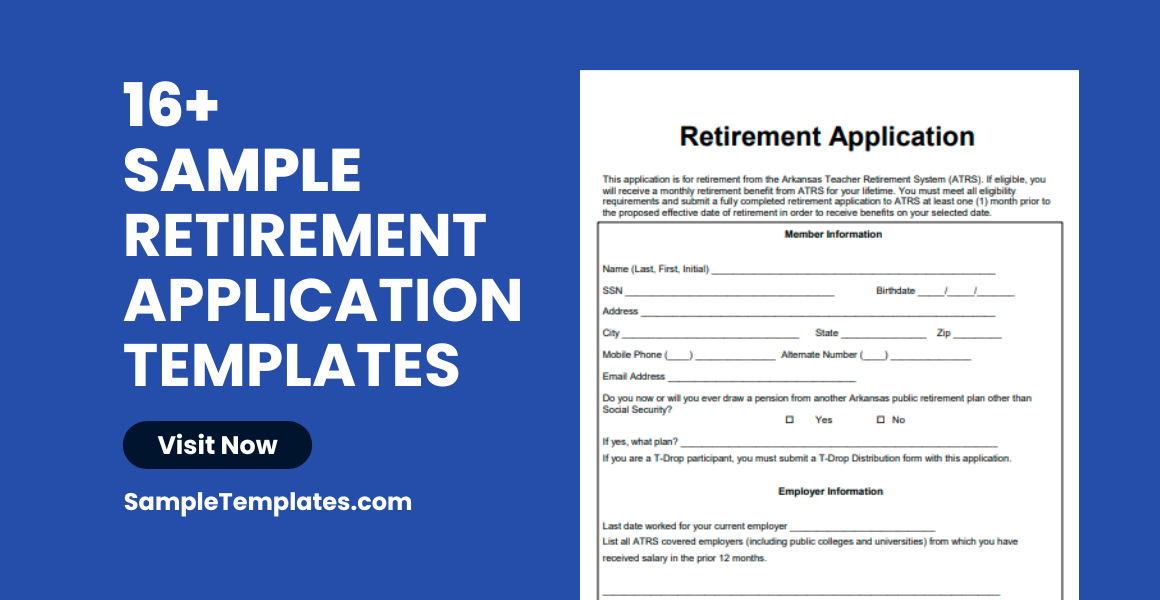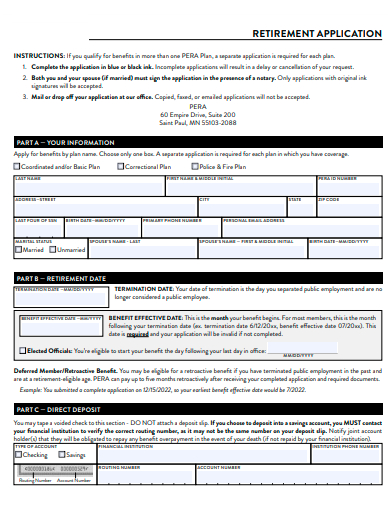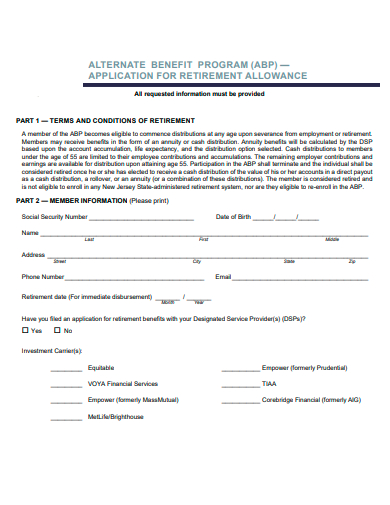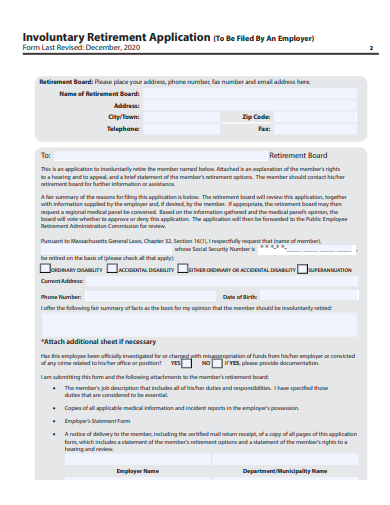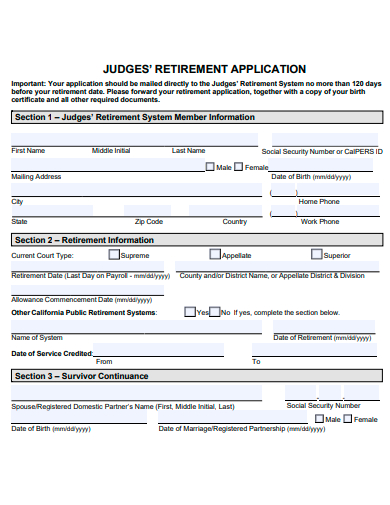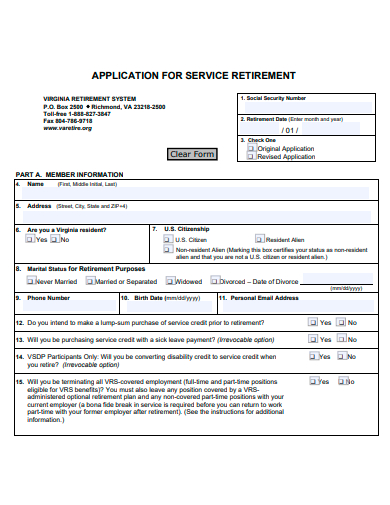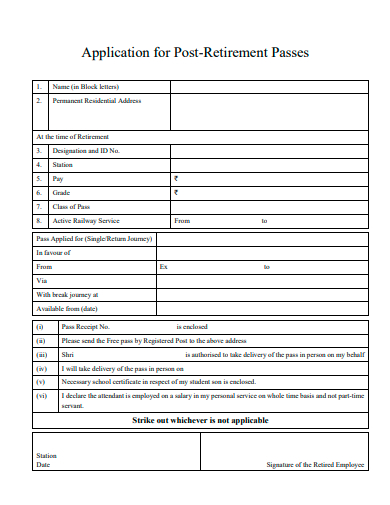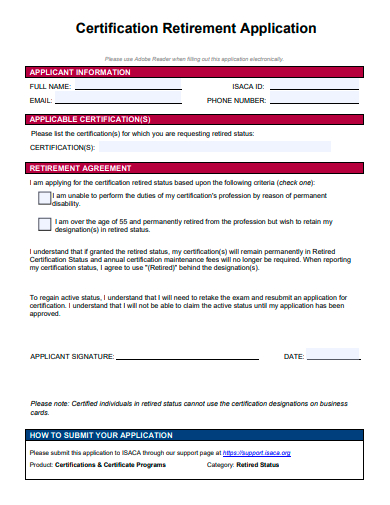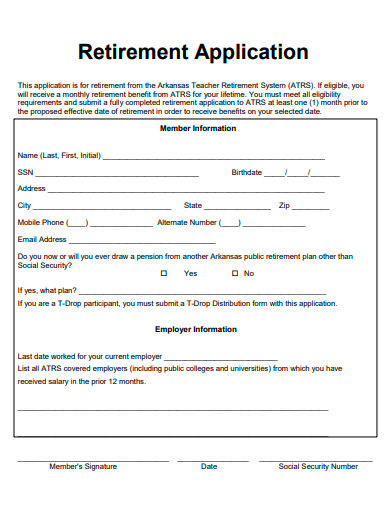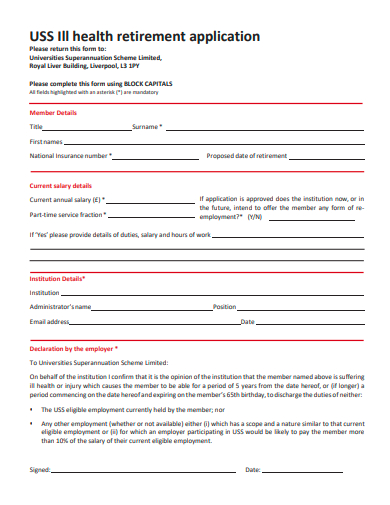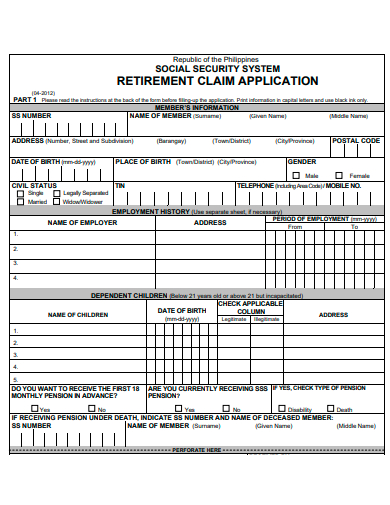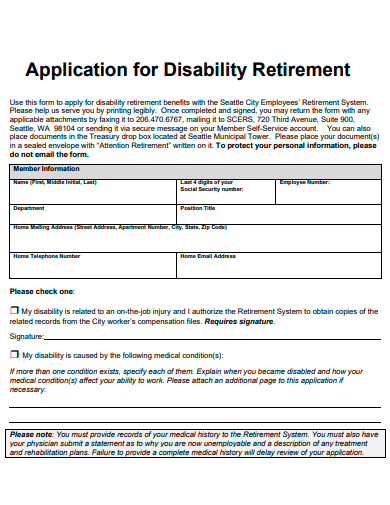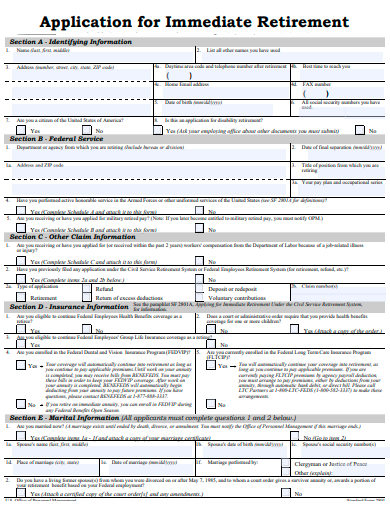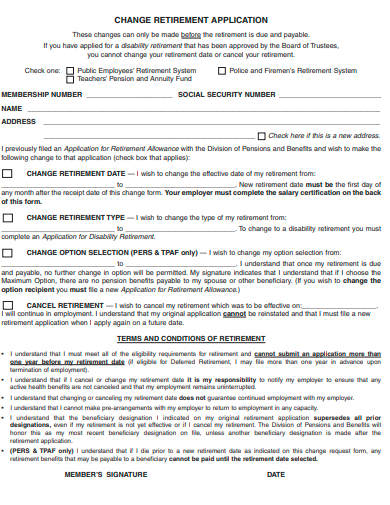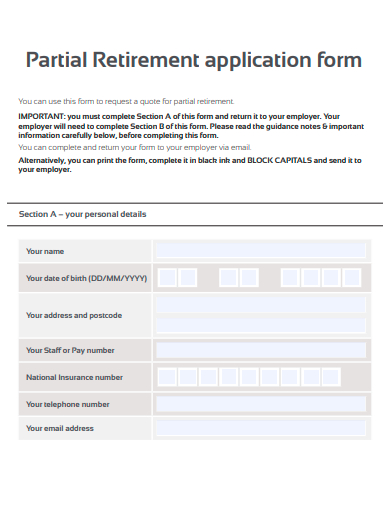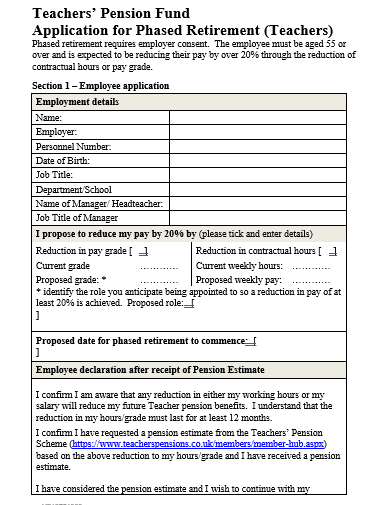Embarking on a new chapter of life, Retirement Application serves as your essential guide to transitioning from work life with ease. This comprehensive document offers step-by-step instructions, ensuring a seamless process for filing your retirement request. Rich with key phrases like retirement sample planning, application process, and financial security, it’s optimized for visibility and user-friendliness, making it the go-to resource for future retirees seeking a stress-free changeover. Prepare to embrace retirement with confidence and clarity. You can also see more templates like Application Format Samples.
16+ Retirement Application Samples
1. Sample Retirement Application Template
2. Sample Retirement Allowance Application Template
3. Sample Involuntary Retirement Application Template
4. Sample Judges Retirement Application Template
5. Sample Service Retirement Application Template
What is a Retirement Application?
Understanding Retirement Applications
When the time comes to transition from a working life to retirement, a significant step involves the submission of a retirement application. This document is not just a formality; it marks the beginning of a new phase of life. But what exactly is a retirement application, and why is it so important? It’s a document similar to a Retirement Letter, but more formal and detailed, marking your intent to leave your professional career.
The Importance of a Retirement Application
A retirement application is much more than a piece of sample paper—it’s a key that unlocks the benefits you’ve worked years to accrue. Whether it’s a government pension plan or a private retirement fund, this document signals your intent to retire and request the pension or retirement benefits you’re entitled to. It’s a step that requires as much attention as when you’re crafting a Retirement Resignation Letter.
Key Components of a Retirement Application
A standard retirement application should contain several critical pieces of information:
- Personal identification details of the applicant
- The official date of retirement
- Employment information, including position and years of service
- Beneficiary information
- Specific retirement plan details
Personal Information Section
In this section, retirees must provide accurate and up-to-date personal information. This includes full names, social security numbers, addresses, contact details, and sometimes next of kin information. This section ensures that all correspondence and benefits are appropriately directed to the retiree. It’s a process that mirrors the attention to detail needed when filling out a Social Security Application Form.
Employment Details
Here, the retiree outlines their employment journey. This typically covers the start and end dates of employment, the positions held, and possibly a brief description of duties if it affects the retirement benefits. It’s akin to summarizing the content of a Retirement Letter Sample.
Choosing the Retirement Date
Deciding on a retirement date is more complex than it appears. It often involves considering the retiree’s age, years of service, and sometimes the timing within a fiscal year to maximize benefits. This section requires the retiree to state their intended last day of work, much like declaring your intentions in a Retirement Resignation Letter Sample.
Understanding Your Retirement Plan
Retirement plans vary widely, from defined benefit plans, commonly known as pensions, to defined contribution plans like 401(k)s. The application should specify which retirement plan is in place and any relevant details that pertain to the payout structure and beneficiaries. This is a critical step, similar to choosing the right Pension Service Claim Form.
Beneficiary Information
This part of the application is vital. The retiree names who will receive benefits in the event of their passing. This often requires additional documentation like marriage certificates or birth certificates for dependents, ensuring the process is as thorough as a Retirement Resignation Letter.
The Process After Submission
Once submitted, the retirement application is reviewed by the employer and the institution managing the retirement funds. This can involve verifying the retiree’s work record, salary history, and confirming eligibility for retirement benefits, much like the verification process for an Annuity Application.
Common Pitfalls in Retirement Applications
Retirees often encounter several pitfalls:
- Missing signatures or documentation
- Inaccurate information which can lead to delays
- Failing to account for tax implications
Examples of Retirement Application Use
Consider John, a school teacher with 30 years of service, who is ready to retire. He completes his retirement application, indicating his last day in the classroom and designating his wife as the primary beneficiary for his pension. By doing so, he ensures a smooth transition into retirement, with his benefits starting right after his retirement date.
Then there’s Maria, who worked in corporate for 25 years and has a 401(k). Her retirement application process involves deciding when to start drawing from her 401(k) and understanding the tax implications of her decisions, similar to the considerations in a Sample Retirement Letter.
Final Checklist Before Submission
- Verify all personal information is accurate.
- Ensure employment details are consistent with records.
- Confirm the retirement date with your employer.
- Double-check the retirement sample plan details.
- Review beneficiary designations and make sure they are up to date.
- Make copies of the entire application for personal records.
Exploring the Uses of Retirement Applications
Retirement applications serve as the linchpin for initiating the retirement process, ensuring that all the years of hard work culminate in a well-deserved, financially secure retirement phase. The uses of these applications are manifold and critical for both the retiring individual and the administrative bodies managing retirement benefits.
Navigating the Process of Filling Out a Retirement Application
Filling out a retirement application is a significant step in transitioning from working life to retirement. It is a detailed process that requires attention to ensure that all benefits are received as expected. Here is a bullet-point guide to help you through the process:
Gather Necessary Documents:
- Personal identification (ID, driver’s license, passport)
- Employment records (including start and end dates)
- Account information for retirement savings plans (like 401(k), IRA)
- Social Security details
- Documents for any other retirement income (e.g., annuities, military benefits)
Understand Your Retirement Plan:
- Review the specific terms of your pension or retirement savings plan
- Know your plan’s normal retirement age and the implications of retiring earlier or later
- Determine if your plan includes cost of living adjustments (COLAs)
Personal Details Section:
- Fill in your full legal name and any previous names (if applicable)
- Provide current address, telephone number, and email address
- Enter Social Security Number and date of birth
Employment Information:
- Confirm your official retirement date with your employer before filling in the application
- Record your job title and department
- Note the number of years you’ve been with the company or organization
Designate Beneficiaries:
- Decide who will receive the benefits in the sample event of your death
- Provide the full legal names, addresses, Social Security Numbers, and birth dates of all beneficiaries
- Determine the percentage of benefits each beneficiary will receive
Tax Withholding:
- Decide whether you want federal and state taxes withheld from your retirement payments
- If so, specify the amount or percentage to withhold
Direct Deposit:
- Provide bank routing and account numbers for direct deposit
- Choose the account type (checking or savings)
Final Review and Signatures:
- Double-check that all information is complete and accurate
- Ensure any required signatures are not missing
- Have a witness sign if necessary, as per your plan’s requirements
Submit the Application:
- Follow the submission guidelines provided by your retirement plan
- Keep a copy of the completed application for your records
Post-Submission Follow-up:
- Confirm receipt of your application with the plan administrator
- Stay in touch with your employer’s human resources department to ensure all necessary steps are completed on their end
- Be prepared to provide additional documentation if requested
Prepare for the Next Steps:
- Start planning for the transition into retirement
- Consider setting up a meeting with a financial advisor to discuss the change in your financial situation
- Review health insurance options, like Medicare or supplemental plans.
6. Sample Post-Retirement Application Template
7. Sample Certification Retirement Application Template
8. Sample Basic Retirement Application Template
9. Sample Health Retirement Application Template
10. Sample Retirement Benefits Application Template
11. Sample Retirement Claim Application Template
12. Sample Disability Retirement Application Template
13. Sample Retirement Program Application Template
14. Sample Immediate Retirement Application Template
15. Sample Change Retirement Application Template
16. Sample Partial Retirement Application Form
17. Sample Teachers Retirement Application Template
How do you Create a Retirement Application?
Creating a retirement application involves designing a sample form that captures all necessary details from an employee who wishes to retire. This form should be straightforward and respectful, acknowledging the significant life transition for the employee. Here’s how to create such an application in five detailed steps:
Step 1: Personal Information and Employment Details
Start the application by requesting all necessary personal information, including the employee’s full name, date of birth, employee identification number, position, department, and contact information. Include a section to record their employment history with the company, such as the date of hire, various positions held, and any significant contributions or achievements. This section honors the employee’s service and creates a record that can be used for ceremonial purposes if the company wishes to celebrate the employee’s retirement.
Step 2: Retirement Specifics
Have the employee specify their intended last day of work, which is essential for HR to process retirement benefits and finalize payroll details. If the company offers different retirement plans or packages, provide a clear explanation of each and include a checklist or selection box for the employee to indicate their choice. If applicable, also ask the employee if they wish to provide a reason for retirement, though this should be optional out of respect for their privacy.
Step 3: Financial Arrangements
In this section, delve into the details of the employee’s retirement benefits. Request the information needed to transfer pension funds or manage annuities, such as the employee’s financial institution, account numbers, and desired distribution methods. If your company provides health benefits or life insurance into retirement, include a subsection for the employee to elect continued coverage or adjust plans. Clear instructions should be provided on how to complete these selections to avoid confusion and ensure proper processing.
Step 4: Acknowledgment of Company Policies and Procedures
Outline any company-specific policies regarding retirement. This might include the return of company property, confidentiality agreements, and information about exit interviews or final performance evaluations. Include a statement for the employee to sign, acknowledging that they understand and agree to these terms. This step is crucial in ensuring a smooth transition and protecting both the employee and the company’s interests.
Step 5: Submission Instructions and Follow-up
Conclude the application with clear instructions on how to submit the completed professional form, the deadline for submission, and any other documents that need to accompany the application, like identification proof or company badge. Provide contact information for the company’s HR representative or retirement coordinator who can assist with any questions. Additionally, detail the next steps in the process after submission, including how the employee will be contacted, any meetings they should expect to attend, and an overview of the sample timeline leading up to their retirement date.
In Conclusion, a retirement application is the first formal step a soon-to-be retiree takes to transition into the next phase of life, ensuring they can rely on the financial benefits they have set up for themselves after years of service in the workforce.
Related Posts
FREE 29+ Student Application Form Samples in PDF | MS Word
FREE 21+ Administrative Application Samples in MS Word | Apple Pages | PDF
FREE 21+ Teacher Application Samples in MS Word | Apple Pages | Outlook | PDF
FREE 25+ Transfer Application Samples in MS Word | Apple Pages | PDF
FREE 23+ Participation Application Samples in MS Word | PDF
FREE 14+ Patient Application Samples in MS Word | PDF
FREE 21+ Eligibility Application Samples in PDF
FREE 20+ Travel Application Samples in PDF | MS Word
FREE 25+ Sponsor Application Sampales in MS Word | Google Docs | Apple Pages | PDF
FREE 23+ Candidate Application Samples in PDF
FREE 33+ Committee Application Samples in PDF | MS Word
FREE 37+ Supplemental Application Samples in PDF | MS Word
FREE 37+ Product Application Samples in PDF | MS Word
FREE 33+ Visiting Application Samples in PDF | MS Word
FREE 34+ Refund Application Samples in PDF | MS Word
